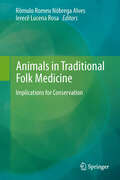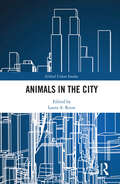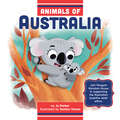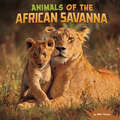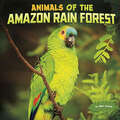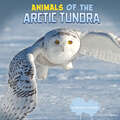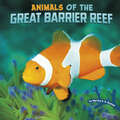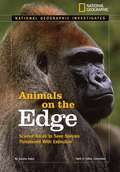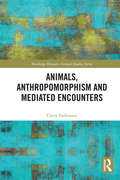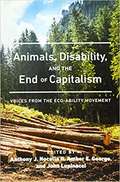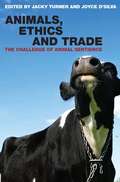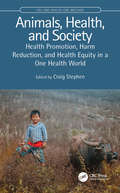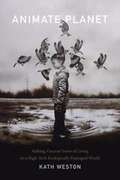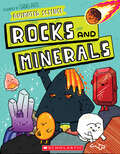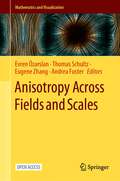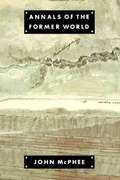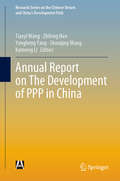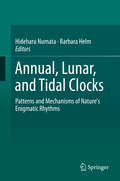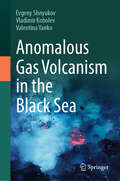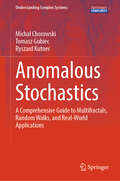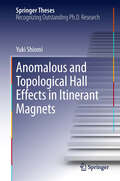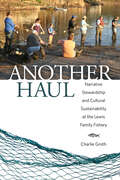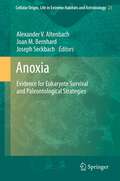- Table View
- List View
Animals in Traditional Folk Medicine: Implications for Conservation
by Ierecê Lucena Rosa Rômulo Romeu AlvesPeople have relied on medicinal products derived from natural sources for millennia, and animals have long been an important part of that repertoire; nearly all cultures, from ancient times to the present, have used animals as a source of medicine. Ingredients derived from wild animals are not only widely used in traditional remedies, but are also increasingly valued as raw materials in the preparation of modern medicines. Regrettably, the unsustainable use of plants and animals in traditional medicine is recognized as a threat to wildlife conservation, as a result of which discussions concerning the links between traditional medicine and biodiversity are becoming increasingly imperative, particularly in view of the fact that folk medicine is the primary source of health care for 80% of the world's population. This book discusses the role of animals in traditional folk medicine and its meaning for wildlife conservation. We hope to further stimulate further discussions about the use of biodiversity and its implications for wildlife conservation strategies.
Animals in Winter (Let's-Read-and-Find-Out Science 1 #1)
by Henrietta Bancroft Richard G. Van GelderRead and find out about how animals cope with winter in this colorfully illustrated nonfiction picture book.This is a clear and appealing book for early elementary age kids, both at home and in the classroom. Introduce kids to basic science ideas as part of discussions about the seasons and animals.Have you ever seen a butterfly in the snow? Probably not. Butterflies can't survive cold weather, so when winter comes, many butterflies fly to warmer places. They migrate. Woodchucks don't like cold weather either, but they don't migrate; they hibernate. Woodchucks sleep in their dens all winter long. How do these and other animals handle the cold and snow of winter?Read and find out in the proven winner Animals in Winter!This is a Level 1 Let's-Read-and-Find-Out, which means the book explores introductory concepts perfect for children in the primary grades. The 100+ titles in this leading nonfiction series are:hands-on and visualacclaimed and trustedgreat for classroomsTop 10 reasons to love LRFOs:Entertain and educate at the same timeHave appealing, child-centered topicsDevelopmentally appropriate for emerging readersFocused; answering questions instead of using survey approachEmploy engaging picture book quality illustrationsUse simple charts and graphics to improve visual literacy skillsFeature hands-on activities to engage young scientistsMeet national science education standardsWritten/illustrated by award-winning authors/illustrators & vetted by an expert in the fieldOver 130 titles in print, meeting a wide range of kids' scientific interestsBooks in this series support the Common Core Learning Standards, Next Generation Science Standards, and the Science, Technology, Engineering, and Math (STEM) standards. Let's-Read-and-Find-Out is the winner of the American Association for the Advancement of Science/Subaru Science Books & Films Prize for Outstanding Science Series.
Animals in the City (Global Urban Studies)
by Laura A. ReeseThis book presents interdisciplinary research to examine the ongoing debates around nonhuman animals in urban spaces. It explores how we can better appreciate and accommodate animals in the city, while also exploring the ecological, health, ethical, and cultural implications of the same. The book addresses seven interrelated themes such as blurred boundaries between the human and the nonhuman, the right of nonhuman species to the city, interactions between the human and nonhuman animals, the fabric of urban space, human and nonhuman complex systems, and collective welfare that forms the basis of a transspecies urban theory. It explains how a holistic understanding of the city requires that these blurred boundaries are acknowledged and critically examined. Chapters analytically consider the need to bring interspecies relationships to the fore to tackle questions of legitimacy and who has the "right" to the city. These also consider important intersections between the economic, political, social, and cultural aspects of the urban experience. The research contained in this book focuses on the development of an urban theory that would eradicate the divide between humans and other species in cities, and it depicts nonhuman animals as social actors that have voices within urban spaces. With global insights on human–animal relationships in a contemporary context, this book will be useful reading for scholars and students of urban studies, animal sciences, animal law, animals and public policy, anthropology, and environmental studies who are interested in the study of animals in cities.
Animals of Australia
by Jo ParkerExplore the Australian Outback to find koalas, kangaroos, crocodiles, and more!Did you know kangaroos can jump 10 feet high? And they can travel up to speeds of 40 miles per hour!Learn more fun facts about some of Australia's favorite animals! In connection with the publication of Animals of Australia, Penguin Random House will donate a portion of the proceeds to support efforts to provide Australian bushfire relief.
Animals of the African Savanna (Wild Biomes)
by Mari SchuhBiomes are home to unique animals and plants. Introduce beginning readers to the African Savanna biome! Readers will get an up-close look at the characteristics of the land and weather and how zebras, lions, giraffes, and other animals have adapted to life in this amazing biome.
Animals of the Amazon Rain Forest (Wild Biomes)
by Mari SchuhBiomes are home to unique animals and plants. Give beginning readers an introductory look at the Amazon rain forest! Readers will get an up-close look at the characteristics of the land and weather and how monkeys, parrots, anacondas, sloths, and other animals have adapted to life in this amazing biome.
Animals of the Arctic Tundra (Wild Biomes)
by Martha E. RustadBiomes are home to unique animals and plants. Give beginning readers an introductory look at the Arctic tundra! Readers will get an up-close look at the characteristics of the land and weather and how polar bears, Arctic hares, snowy owls, and other animals have adapted to life in this amazing biome.
Animals of the Great Barrier Reef (Wild Biomes)
by Martha E. RustadBiomes are home to unique animals and plants. Introduce beginning readers to the Great Barrier Reef! Readers will get an up-close look at the characteristics of the reef and how corals, fish, anemones, rays, birds, and other animals have adapted to life in and around this amazing biome.
Animals of the Sea and Shore: A True Book
by Ann O. SquireWhen you go to the beach, how many animals do you see? A crab scooting across the sand? A gull bobbing in the waves or pecking at a shell washed up on the shore? The sea and the shoreline are home to thousands of different creatures. They range from the tiniest snail to the great blue whale--and just about everything in between.
Animals on the Edge: Science Races to Save Species Threatened with Extinction
by Sandra PobstThe informed and educational narrative examines numerous threats to animals in the wild, raising awareness of each species, and detailing the extent and urgency of the problem. The book also encourages young animal lovers to take an active role in the preservation of creatures great and small.
Animals, Anthropomorphism and Mediated Encounters (Routledge Human-Animal Studies Series)
by Claire ParkinsonThis book critically investigates the pervasiveness of anthropomorphised animals in popular culture. Anthropomorphism in popular visual media has long been denounced for being unsophisticated or emotionally manipulative. It is often criticised for over-expressing similarities between humans and other animals. This book focuses on everyday encounters with visual representations of anthropomorphised animals and considers how attributing other animals with humanlike qualities speaks to a complex set of power relations. Through a series of case studies, it explores how anthropomorphism is produced and circulated and proposes that it can serve to create both misunderstandings and empathetic connections between humans and other animals. This book will appeal to academics and students interested in visual media, animal studies, sociology and cultural studies.
Animals, Disability, and the End of Capitalism: Voices from the Eco-Ability Movement (Radical Animal Studies and Total Liberation #1)
by John Lupinacci Anthony J. Nocella Amber E. George<p>Animals, Disability, and the End of Capitalism is a collection of essays from the leaders in the field of eco-ability. The book is rooted in critical pedagogy, inclusive education, and environmental education. The efforts of diverse disability activists work to weave together the complex diversity and vastly overlooked interconnections among nature, ability, and animals. Eco-ability challenges social constructions, binaries, domination, and normalcy. Contributors challenge the concepts of disability, animal, and nature in relation to human and man. Eco-ability stresses the interdependent relationship among everything and how the effect of one action such as the extinction of a species in Africa can affect the ecosystem in Northern California. Animals, Disability, and the End of Capitalism is timely and offers important critical insight from within the growing movement and the current academic climate for such scholarship. The book also provides insights and examples of radical experiences, pedagogical projects, and perspectives shaped by critical animal studies, critical environmental studies, and critical disability studies. <p>Contributors include Sarah R. Adams, Marissa Anderson, Judy K. C. Bentley, Mary Fantaske, Amber E. George, Ava HaberkornHalm, John Lupinacci, Hannah Monroe, Anthony J. Nocella II, Nicole R. Pallotta, Meneka Repka, and Daniel Salomon.</p>
Animals, Ethics and Trade: The Challenge of Animal Sentience
by Joyce D'Silva Jacky TurnerModern urban life cuts us off from direct connection with the animal world, yet daily the lives of millions of animals are affected by what we consume and wear and what we trade in. The use of animals for food, labour and pleasure pursuits has long been justified with the assumption that unlike humans, animals aren't fully sentient beings. In recent years, however, science has revealed an astonishing array of complex animal behaviour, and scientists and policy makers now accept that the animals we make use of are indeed conscious, with preferences and intentions. The implications for our culture of factory farming, fast food and rainforest liquidation are staggering. In this powerful book, internationally renowned experts on animal behaviour and agriculture such as Jane Goodall, Tim Lang and Vandana Shiva are brought together with ethicists, religious scholars, international industry and regulators for the first time to debate these critical issues and tackle the profound implications of animal sentience. ? The first sections discuss scientific and ethical perspectives on the consciousness, emotions and mental abilities of animals. Later sections address how human activities such as science, law, religion, farming, food production, trade, development and education respect or ignore animals' sentience and welfare, and review the options for changes in our policies, our practices and our thinking. The result is nothing less than a stark and necessary look into the heart of humanity and the ethics that govern our animal powered society.
Animals, Health, and Society: Health Promotion, Harm Reduction, and Health Equity in a One Health World (CRC One Health One Welfare)
by Craig StephenThis timely book reframes the historic narrative of people, animals, and nature as risks to each other, to one where we think about health as a shared capacity. This new narrative promotes the positive contributions made to health across species and generations and addresses growing calls to shift from a reactive to proactive approach in One Health. Editor Craig Stephen takes the reader on a tour of the situations wherein we can all, regardless of our job description, work across species, sectors, and generations to motivate action. Perspectives and methods from a variety of fields and experts are shared and adapted to promote collaborative understanding of and action on determinants of health at the animal-society interface. Case studies demonstrate that the principles and practices presented are feasible, empowering people to make choices that concurrently benefit the health of animals, societies, and ecosystems. The first book to adapt and explain health promotion, harm reduction, and health equity issues in a One Health context, and in terms of animal health, this is necessary reading for students of and practitioners working in planetary health, conservation, ecohealth, public health, health promotion, veterinary medicine, and animal welfare.
Animate Planet: Making Visceral Sense of Living in a High-Tech Ecologically Damaged World
by Kath WestonIn Animate Planet Kath Weston shows how new intimacies between humans, animals, and their surroundings are emerging as people attempt to understand how the high-tech ecologically damaged world they have made is remaking them, one synthetic chemical, radioactive isotope, and megastorm at a time. Visceral sensations, she finds, are vital to this process, which yields a new animism in which humans and "the environment" become thoroughly entangled. In case studies on food, water, energy, and climate from the United States, India, and Japan, Weston approaches the new animism as both a symptom of our times and an analytic with the potential to open paths to new and forgotten ways of living.
Animated Science: Rocks and Minerals (Animated Science)
by John FarndonRocks and minerals come alive in the next Animated Science book, an outstanding comic series illustrated by Shiho Pate!From gemstones to fossils and beyond, Animated Science: Rocks and Minerals is the definitive guide to rocks and minerals for grade school readers. In this book, readers will explore the substances that make up our Earth through comic illustrations and hilarious characters.With a narrative nonfiction text, kid-friendly information, and Shiho Pate's engaging illustrations, Animated Science: Rocks and Minerals is a perfect introduction and ready reference, appealing and laugh-out-loud funny. Easily accessible for readers just learning, with more interesting facts and details for older kids honing their knowledge.Great for all ages!
Anisotropy Across Fields and Scales (Mathematics and Visualization)
by Thomas Schultz Andrea Fuster Evren Özarslan Eugene ZhangThis open access book focuses on processing, modeling, and visualization of anisotropy information, which are often addressed by employing sophisticated mathematical constructs such as tensors and other higher-order descriptors. It also discusses adaptations of such constructs to problems encountered in seemingly dissimilar areas of medical imaging, physical sciences, and engineering. Featuring original research contributions as well as insightful reviews for scientists interested in handling anisotropy information, it covers topics such as pertinent geometric and algebraic properties of tensors and tensor fields, challenges faced in processing and visualizing different types of data, statistical techniques for data processing, and specific applications like mapping white-matter fiber tracts in the brain.The book helps readers grasp the current challenges in the field and provides information on the techniques devised to address them. Further, it facilitates the transfer of knowledge between different disciplines in order to advance the research frontiers in these areas.This multidisciplinary book presents, in part, the outcomes of the seventh in a series of Dagstuhl seminars devoted to visualization and processing of tensor fields and higher-order descriptors, which was held in Dagstuhl, Germany, on October 28–November 2, 2018.
Annals of the Former World
by John McpheeJohn McPhee describes a cross-section of North America and comes to an understanding not only of the science but of the style of the geologists he traveled with. Completed in four stages under the collected title: Annals of the Former World. <P><P> Winner of the Pulitzer Prize.
Annual Report on The Development of PPP in China (Research Series on the Chinese Dream and China’s Development Path)
by Tianyi Wang Zhifeng Han Yongheng Yang Shouqing Wang Kaimeng LiThis book gathers invited top experts on Public-Private partnership (PPP) in China, from both theoretical and practical fields, to present the most comprehensive analyses of PPP’s practice in China up to 2017. This timely book offers researchers and practitioners a thorough understanding of the PPP’s development in China, including its definition, its modes, its features as well as its many kinds of applications into different industries including medical care, environmental protection, education, public works, park development, etc. It addresses diverse themes in PPP analyses such as quantitative analyses and qualitative analyses; data statistics and case study, theoretical framework modeling and field study verification. The book is an overview of the Chinese PPP development through 2017.
Annual, Lunar, and Tidal Clocks: Patterns and Mechanisms of Nature's Enigmatic Rhythms
by Hideharu Numata Barbara HelmThere is more to biological rhythms than circadian clocks. This book aims at promoting the exciting potential of a deeper understanding of circannual, circatidal, and circalunar clocks. It highlights new developments, summarizes existing knowledge, and integrates different perspectives with the tools and ideas of diverse fields of current biology. For predominantly pragmatic reasons, research in recent decades was mostly concerned with circadian clocks. Clocks on other timescales, however, have been largely neglected and therefore still appear "enigmatic". Thanks to the rapid development of methods in molecular biology as well as in ecology, we are now able to re-approach these clocks. Laboratories around the world are showing fresh interest and substantial progress is being made in many independent projects. The book's two sections address the moon-derived circatidal, circasemilunar, and lunar cycles on the one hand (10 chapters), and the sun-derived circannual cycles on the other (6 chapters). This work brings together authors with an expansive array of expertise and study systems, ranging from tidal cycles of marine invertebrates to annual cycles of birds and mammals, and from behavioral to genetic and epigenetic backgrounds. While great challenges remain to be mastered, the book aims at conveying the excitement of unraveling, broadly, the rhythms of life.
Anomalous Gas Volcanism in the Black Sea
by Evgeny Shnyukov Valentina Yanko Vladimir KobolevIn the Black Sea, an unprecedented intensity of gas discharge of the seabed in the form of jet emissions (gas seeps, torches, flares) and fountains of gas emissions from mud volcanoes have been established, which are described in detail in the monograph. However, the main attention is paid to anomalous single-stage methane emissions as a result of the famous Yalta earthquakes of 1927, accompanied by amazing and mysterious fiery phenomena. An analysis of the available geological and geophysical materials indicates that the fire phenomena were caused by massive methane emissions as a result of a powerful mantle gas-fluid flow into decompaction zones of the crystalline basement along tectonic faults of various scales within the Odessa-Sinop and Circum-Black Sea fault zones. Earthquakes served as a trigger for the activation of tectonic disturbances in the near-bottom sedimentary horizons for the migration of focused deep gas-fluid flows. The deep structure of the source zones and the nature of the seismic process are analyzed, the nature of the manifestations of fire phenomena is assessed. The enormous volumes of gas emissions are noted – millions of cubic meters of methane, which are proposed as a kind of gas plume, the nature of which is associated with zones of deep faults in the upper mantle. Using the geological and geophysical materials obtained in recent years, the authors significantly refined the structural-tectonic construction and localization of gas-mud activity in the Black Sea water area. All these new materials, along with an analysis of the available data on the seismicity of the Crimean region, open up the possibility of explaining the fiery phenomena that were observed during the Yalta earthquakes of 1927 and facilitate the interpretation and understanding of their nature.
Anomalous Stochastics: A Comprehensive Guide to Multifractals, Random Walks, and Real-World Applications (Understanding Complex Systems)
by Michał Chorowski Tomasz Gubiec Ryszard KutnerThis textbook provides a comprehensive exploration of anomalous stochastic processes and extreme events, commonly referred to as "black swans," with a particular focus on (multi-)fractal approaches and continuous-time random walks. The authors present a systematic examination of the subject, tracing its inception and providing a multi-directional perspective. By drawing on real-world experiences in finance, physics, and technology, the book underscores the practical relevance of anomalous stochastic processes for practitioners dealing with real-world data from complex systems. The content is based on a series of interdisciplinary physics lectures that have been delivered to undergraduate and graduate students at the University of Warsaw for nearly two decades. Updated to reflect recent developments, this book is a valuable resource for graduate students, ambitious undergraduate students, and researchers interested in random processes and the practical implications of anomalous processes. Familiarity with fundamental principles of probability theory, algebra, and basic concepts of differential and integral calculus is assumed, while a foundational understanding of mathematical statistics, stochastic processes, and statistical thermodynamics is recommended. Additionally, each chapter includes practical exercises designed to help readers master the concepts, develop practical skills, and serve as teaching material.
Anomalous and Topological Hall Effects in Itinerant Magnets (Springer Theses)
by Yuki ShiomiThis book presents an investigation of the anomalous and topological Hall effects in some itinerant ferromagnets and helimagnets by measurements of Hall effects driven by electrical or heat current. New clarifications are provided for spin-dependent Hall effects induced by the Berry phase, skew scattering, and scalar spin chirality. The author reveals the scattering-free nature of the Berry-phase-induced anomalous Hall current by conducting the first comparative study of electrical and thermal Hall effects. The impurity-element dependence of the anomalous Hall effect caused by skew scattering is systematically investigated in the low-resistivity region for Fe. Two new examples showing a topological Hall effect are found in helimagnets, in which nonzero scalar spin chirality arises from the modulation of spin structure through Dzyaloshinsky-Moriya (DM) interaction. Such a DM-interaction-mediated topological Hall effect is a new type of topological Hall effect. Also the temperature dependence of topological Hall terms in the thermal Hall effect and Nernst-Ettingshausen effect is found to be totally different from that in the electrical Hall effect. These results will be useful for applications of spin current to devices with low power consumption.
Another Haul: Narrative Stewardship and Cultural Sustainability at the Lewis Family Fishery (Folklore Studies in a Multicultural World Series)
by Charlie GrothLewis Island in Lambertville, New Jersey, is the site of the Lewis Fishery, the last haul seine American shad fishery on the nontidal Delaware River. The Lewis family has fished in the same spot since 1888 and operated the fishery through five generations. The extended Lewis family, its fishery’s crew, and the Lambertville community connect with people throughout the region, including environmentalists concerned about the river. It was a Lewis who raised the alarm and helped resurrect a polluted river and its biosphere. While this once exclusively masculine activity is central to the tiny island, today men, women, and children fish, living out a sense of place, belonging, and sustainability.In Another Haul: Narrative Stewardship and Cultural Sustainability at the Lewis Family Fishery, author Charlie Groth highlights the traditional, vernacular, and everyday cultural expressions of the family and crew to understand how community, culture, and the environment intersect. Groth argues there is a system of narrative here that combines verbal activities and everyday activities.On the basis of over two decades of participation and observation, interviews, surveys, and a wide variety of published sources, Groth identifies a phenomenon she calls “narrative stewardship.” This narrative system, emphasizing place, community, and commitment, in turn, encourages environmental and cultural stewardship, tradition, and community. Intricate and embedded, the system appears invisible, but careful study unpacks and untangles how people, often unconsciously, foster sustainability. Though an ethnography of an occupation, the volume encourages readers to consider what arises as special about all cultures and what needs to be seen and preserved.
Anoxia: Evidence for Eukaryote Survival and Paleontological Strategies (Cellular Origin, Life in Extreme Habitats and Astrobiology #21)
by Joseph Seckbach Joan M. Bernhard Alexander AltenbachANOXIA defines the lack of free molecular oxygen in an environment. In the presence of organic matter, anaerobic prokaryotes produce compounds such as free radicals, hydrogen sulfide, or methane that are typically toxic to aerobes. The concomitance of suppressed respiration and presence of toxic substances suggests these habitats are inhospitable to Eukaryota. Ecologists sometimes term such environments 'Death Zones'. This book presents, however, a collection of remarkable adaptations to anoxia, observed in Eukaryotes such as protists, animals, plants and fungi. Case studies provide evidence for controlled beneficial use of anoxia by, for example, modification of free radicals, use of alternative electron donors for anaerobic metabolic pathways, and employment of anaerobic symbionts. The complex, interwoven existence of oxic and anoxic conditions in space and time is also highlighted as is the idea that eukaryotic inhabitation of anoxic habitats was established early in Earth history.
